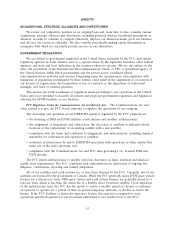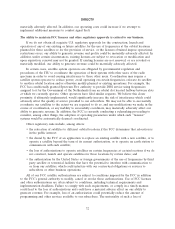DIRECTV 2009 Annual Report Download - page 35
Download and view the complete annual report
Please find page 35 of the 2009 DIRECTV annual report below. You can navigate through the pages in the report by either clicking on the pages listed below, or by using the keyword search tool below to find specific information within the annual report.DIRECTV
In addition, cable television operators have grown their subscriber bases through mergers and
acquisitions, and a recent federal appeals court decision invalidating the cap on the number of
subscribers a single cable operator may allow them additional avenues for growth. Moreover, mergers,
joint ventures and alliances among franchise, wireless or private cable television operators, telcos,
broadband service providers and others may result in providers capable of offering bundled television,
data and telecommunications services in competition with our services.
We do not currently offer local channel coverage to markets covering approximately five percent of
U.S. television households, which places us at a competitive disadvantage in those markets. We also
have been unable to secure certain international programming, due to exclusive arrangements of
programming providers with certain competitors, which has constrained our ability to compete for
subscribers who wish to obtain such programming. And as discussed below, certain cable-affiliated
programmers have withheld their programming from us in certain markets, which has further
constrained our ability to compete for subscribers in those markets.
In the United States, various telcos and broadband service providers have deployed fiber optic
lines directly to customers’ homes or neighborhoods to deliver video services, which compete with the
DIRECTV service. It is uncertain whether we will be able to increase our satellite capacity, offer a
significant level of new services in existing markets in which we compete or expand to additional
markets as may be necessary to compete effectively. Some of these various telcos and broadband
service providers also sell the DIRECTV service as part of a bundle with their voice and data services.
A new broadly-deployed network with the capability of providing video, voice and data services could
present a significant competitive challenge and, in the case of the telcos currently selling the DIRECTV
service, could result in such companies focusing less effort and resources selling the DIRECTV service
or declining to sell it at all. We may be unable to develop other distribution methods to make up for
lost sales through the telcos.
As a result of these and other factors, we may not be able to continue to expand our subscriber
base or compete effectively against cable television or other MVPD operators in the future.
Emerging digital media competition could materially adversely affect us.
Our business is focused on television, and we face emerging competition from other providers of
digital media, some of which have greater financial, marketing and other resources than we do. In
particular, programming offered over the Internet has become more prevalent as broadband networks
have improved their speed and quality of service. Significant changes in consumer behavior with regard
to the means by which they obtain video entertainment and information in response to this emerging
digital media competition could materially adversely affect our revenues and earnings or otherwise
disrupt our business.
We depend on others to produce programming and programming costs are increasing.
We depend on third parties to provide us with almost all of our programming services, including
third parties who are our affiliates and third parties controlled by competitors. As discussed below, a
limited number of cable-affiliated programmers have in the past denied us access to their programming.
Our ability to compete successfully will depend on our ability to continue to obtain desirable
programming and deliver it to our subscribers at competitive prices. Our programming agreements
generally have remaining terms ranging from less than one to up to ten years and contain various
renewal and cancellation provisions. We may not be able to renew these agreements on favorable
terms, or at all, or these agreements may be canceled prior to expiration of their original terms. If we
are unable to renew any of these agreements or the other parties cancel the agreements, we may not
23
























